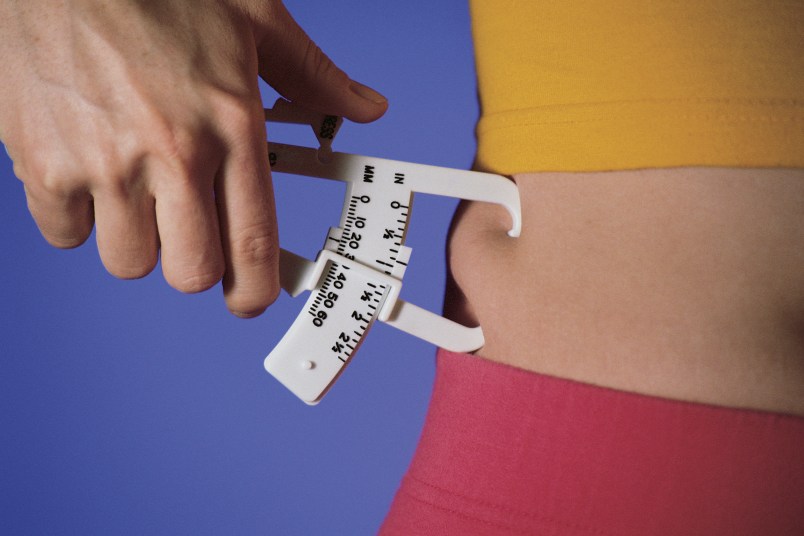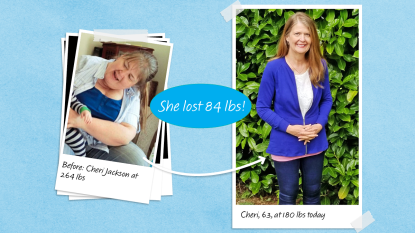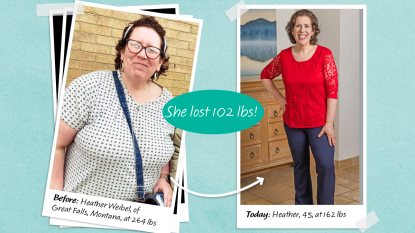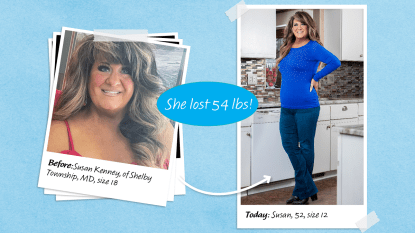Where Does Fat Go When You Lose Weight?

Have you ever wondered “Where does fat go when you lose weight?” You could be mistaken for believing it leaves the body as poop or urine — at least, that’s what many people think is what happens to fat when you lose weight. But the reality is much different. When it comes to the question of where does the fat go when you are losing weight, the answer is that we simply breathe it out. Confused? We’ll explain.
What happens to fat as you lose weight?
A December 2014 study published in BMJ sought to answer the question “Where does fat go once you lose weight?” In the experiment, researchers tracked the atoms in 10 kilograms (about 22 pounds) of fat to see what happened to them when participants lost weight. They found that 8.4 kilograms (about 18.5 pounds) were excreted as carbon dioxide, while the remaining 1.6 kilograms (about 3.5 pounds) left the body as a fluid of some sort: sweat, pee, poop, or other bodily fluids.
So, you lose weight mainly by breathing it out after it’s been converted to carbon dioxide. Does that mean you can just breathe quickly to shed some extra pounds? Not so fast. Speeding up your inhalations and exhalations will only succeed in causing you to hyperventilate, which may lead to dizziness and anxiety. There’s only one way to up your carbon dioxide production: exercise.
Fortunately, exercise is a relatively broad term that can include motions as simple as getting up and walking. The more intense your movements, the faster your breaths will become, and the more carbon dioxide you’ll release. Of course, the key to losing weight is that the amount your body burns must be more than the amount you’re feeding it. You can exercise all you want, but if you continue to consume more calories than you burn, you won’t see your middle shrink at all. Dieting in conjunction with exercise is key.
What happens to fat cells after you lose weight?
It’s important to note that the carbon dioxide you’re breathing out when you’re running isn’t made up of the fat cells themselves. It may be a bit of a bummer to learn that the proper response to the question, “What happens to fat cells when you lose weight?” is not that you lose them but rather that they shrink in size.
From the moment you were born, the number of fat cells in your body increases until you hit your 20s, at which point they plateau. When fat cells die, they’re quickly replaced by more, so the number of fat cells in your body stays relatively even throughout the rest of your life. As for how many fat cells a person has, that figure varies from person to person. You can’t look at someone who is obese and a person who is skinny and say, “The overweight person has more fat cells in his or her body.” It’s what’s inside those fat cells that determines what you see on the outside.
The sad news here is that a person can never “lose” fat cells — they can only increase their fat cell count, according to Kirsty L. Spalding, PhD, a researcher at Karolinska Institutet in Sweden. This fact could explain the body’s urge to gain more weight after you lose it. (No, you’re not wrong in thinking that your body is essentially working to undo all the weight you just lost.) In order to maintain your weight loss, you need to continue to exercise and watch what you eat so that your fat cells stay small.
What happens to fat after liposuction?
We know we just told you that you can’t “lose” fat cells, but what we really meant is that you can’t lose them naturally. If you opt for a procedure like liposuction, then the answer to “What happens to fat cells after liposuction?” is that they’re well and truly gone. Your doctor will suck them out and dispose of the fat (or reinject it in another area of the body that needs plumping).
That said, deciding to have liposuction doesn’t guarantee that you won’t regain the weight you had sucked out. You now must deal with all the other fat cells you didn’t have removed. Those little guys are just as willing to be plumped up as the ones you just got rid of. Even more concerning is that, because you’ve removed fat cells in a troublesome area of your body, they’ll reappear somewhere you may not expect if you tack on a few pounds.
In a July 2011 study published in the journal Obesity, researchers looked at whether women who had liposuction gained back the weight, and if they did, where the weight appeared. It only took a year for the weight that had been suctioned off to reappear, only this time it did not return to the thighs or abdomen where they had the liposuction. Instead, “it was redistributed upstairs,” in the arms, shoulders, and upper abdomen, researcher Robert H. Eckel said. (Researchers aren’t sure if the weight gain was the result of new fat cells forming or old fat cells getting larger.)
Liposuction becomes a cruel game of tag. Once you have the procedure done and “tag” your goal weight, the flab reappears somewhere else. Then, you’re forced to decide whether it’s worth it to have the surgery again for your new problem area or live with your carry-ons.
What happens to fat after CoolSculpting?
OK, so maybe you’re not so keen on the idea of liposuction — but what about CoolSculpting? What happens to fat after CoolSculpting? This relatively new procedure (it was only approved by the Food and Drug Administration in 2010) involves freezing your fat cells gradually using a cooling plate that’s a chilly minus seven degrees Celsius. The low temperatures kill your fat cells, but the machine prevents the rest of your body from getting frostbite. Then, a doctor will usually massage the area and you’re on your way.
CoolSculpting is more convenient than liposuction in a lot of ways: The procedure is less invasive, and there’s a shorter downtime (if any) between treatments. But unlike liposuction, CoolSculpting is marketed as a solution to problem spots, not an all-over treatment.
As for what happens to fat after CoolSculpting, doctors will tell you that you simply pee or poop it out. (Perhaps the answer to the question “When you lose weight, do you poop it out?” is kinda, sorta, maybe.) When cells die, your body will metabolize them, take any nutrients it needs, and excrete them. But as was the case for liposuction, if you don’t maintain your weight loss after CoolSculpting, the chub will return to other parts of the body.
Where does fat go first when you lose weight?
A common concern for women who want to slim down is when you lose weight, where does the fat go first? Ladies who are happy with their breast size worry that their chest is the first area of their body where they’ll lose weight. But the good news (or bad news, depending on how you look at it) is that you can’t target specific sections for weight loss. Sure, you can go to the gym and do a million crunches if you want to tighten your midsection, but there’s no guarantee that you’re going to lose fat there first.
If you know that your chest is usually the first place where you gain weight, then it’s a good guess that it’ll be the first place where you’ll lose weight. This goes for legs, arms, tummy, you name it.
One thing that will make losing weight around the butt, hips, and thigh area especially difficult for women is our own biology. Our bodies want to ensure we’re ready to get pregnant (even if we aren’t!), so that means maintaining a cushion of fat in those aforementioned areas, which are important for childbearing. That’s why it’ll take some time to see these pockets of fat melt off even if you target these areas with specific exercises.
Where does fat go first when you gain weight?
Similar to the question of when you lose weight, the answer to where does fat go when you gain weight is that it’s different for everyone. Female hormones cause fat to settle in the thigh and bum areas. The only way to change that is to alter your hormones. Your problem spots — aka the places where you hold onto excess weight — may be a silent indicators of an underlying health condition.
A January 2008 study published in the Canadian Medical Association Journal conducted by researchers at Harvard and the University of Toronto found a concerning link between a woman’s chest size and her risk for type 2 diabetes. The bigger a female participant’s breasts, the higher her chance of developing the disease. In a 2012 study presented at the American Heart Association’s yearly meeting, researchers at Johns Hopkins noted that people with extra tummy fat were more likely to have restless leg syndrome, a condition that negatively affected their sleep. And the University of Chicago put out a paper in 2010 that noted that women with weight on their hips (known as “pear” body shapes) had poorer brain function than their slimmer peers.
But it’s not all bad. In a June 2010 review in the International Journal of Obesity by researchers at the University of Oxford and Churchill Hospital, the results suggested that women with a bigger posterior were protected from diabetes and heart disease by the extra layer of fat in their tush. A September 2009 study published in BMJ found that women with smaller thighs had an increased risk of heart disease and premature death.
Now that you know what happens to body fat when you lose weight, you can marvel at the miracle that is the human body. Losing weight is hard — especially when your body is basically programmed to work against you — but it’s truly astounding to learn just how efficiently you get rid of fat cells when you burn them. The next time you’re struggling to stay positive about losing weight or are feeling like reducing your belly fat is impossible, take a deep breath and let the weight float away — literally.
More From FIRST
Eat This, Not That: Healthier Options for When You Can’t Shake Off Your Fast Food Cravings
7 ‘Negative-Calorie’ Foods That Help You Stay Satisfied While Dieting
6 Foods That’ll Give You a Calcium Fix When You’re Looking to Skip the Milk













